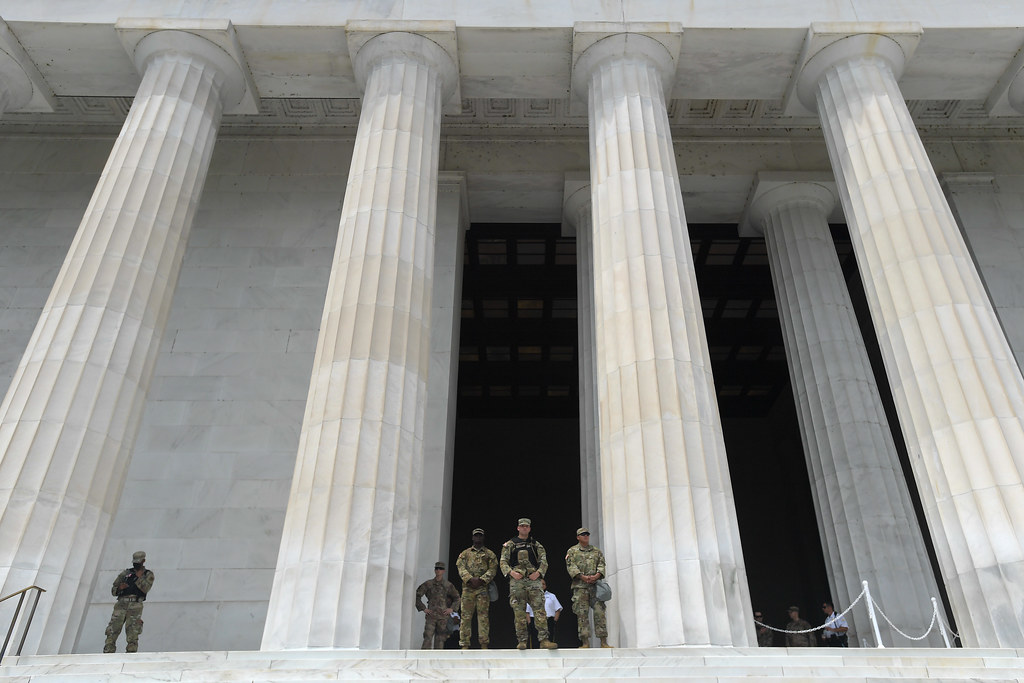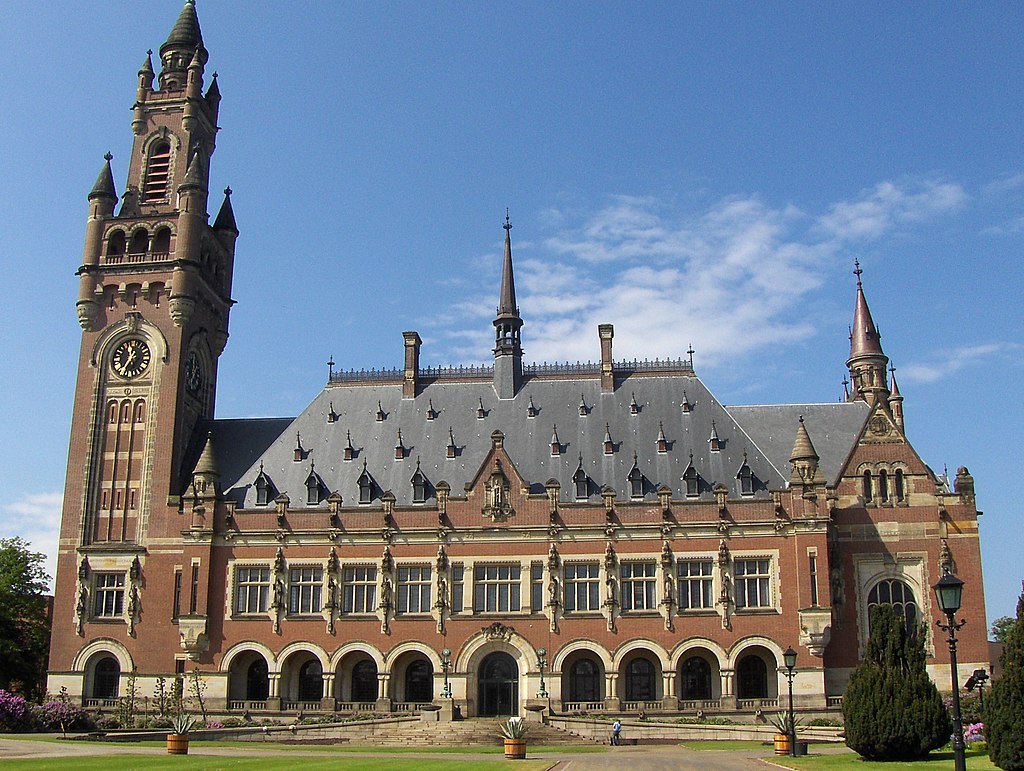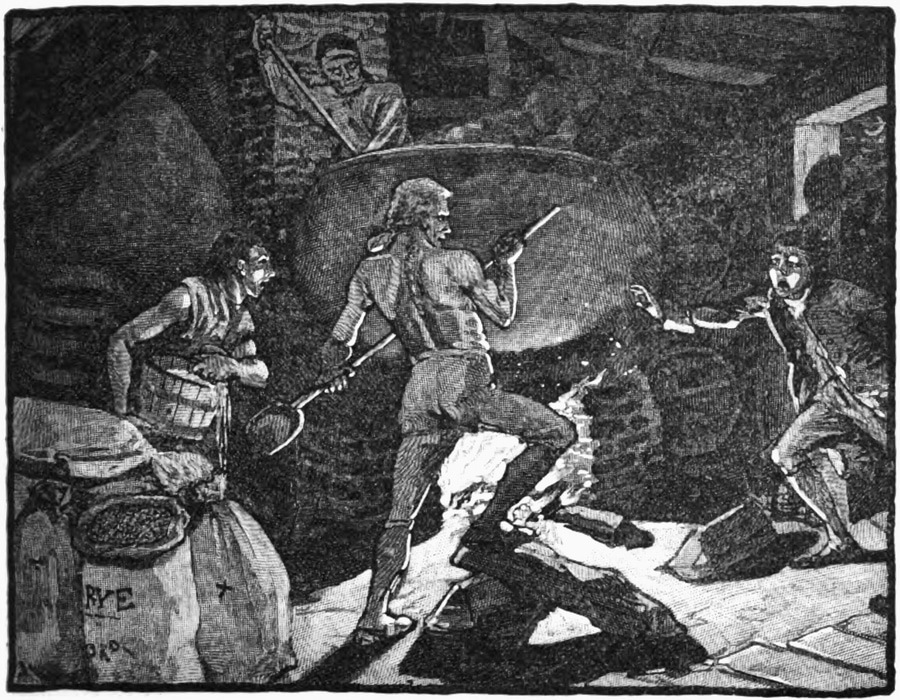Why Were Out-of-State National Guard Units in Washington, D.C.? The Justice Department’s Troubling Explanation
Either the Justice Department’s legal reasoning is wrong, or it’s right—in which case Congress should close the loophole immediately.

Published by The Lawfare Institute
in Cooperation With

Over the previous week, thousands of National Guard troops from states across the country arrived in Washington, D.C., as part of the Trump administration’s response to the largely peaceful protests taking place across the city. After a great deal of controversy—including an argument over whether troops were allegedly kicked out of their hotels by D.C. Mayor Muriel Bowser—they have now departed back to their home states. But under what legal authority were they deployed to D.C. in the first place? The answer was not obvious, and the administration initially remained silent as to its reasoning. Now, in a letter to Mayor Bowser, Attorney General William Barr has cleared up that mystery, explaining that the out-of-state National Guard troops were there under the authority of 32 U.S.C. § 502(f).
In solving one mystery, however, Barr unearthed several more. One of two things is true: Either § 502(f) does not authorize the use of out-of-state National Guard troops in the manner in which they were deployed in Washington last week, or it does—and is therefore a stunningly broad authorization for the president to use the military at any time and for any reason, including as a backdoor around the Posse Comitatus Act. Simply put, either Barr is wrong, or he’s right—in which case Congress should immediately close the loophole he’s identified (and, apparently, seized upon).
When on duty, state National Guard troops can wear three different “hats.” The first, and most common, is “State Active Duty” (SAD) status, in which they are exercising state functions at the request of the state government and are generally governed by state law. For example, when Minnesota Governor Tim Walz mobilized the Minnesota National Guard to help restore order in Minneapolis in the midst of the protests and violence arising from the murder of George Floyd, those troops were there in their SAD capacity. This first “hat” is often described as “Title 32” status (a reference to that part of the U.S. Code that deals with the National Guard), but that’s incorrect. “Title 32” status is actually the second “hat,” pursuant to which the state National Guard troops remain subject to state command and control but are used for federal missions authorized by Congress—and, perhaps most importantly, are usually paid for by the federal government.
Finally, the third hat, “Title 10” status, is when state National Guard units are “federalized” by the president of the United States pursuant to one of the specific statutory authorities for doing so. Once federalized, National Guard troops come under the full command and control of the Pentagon—specifically the secretary of defense. In essence, National Guard troops become part of the federal military until and unless they are returned to state status.
These distinctions matter for a number of reasons, including which government pays for the troops, which government can be held liable if something goes wrong, which military justice system applies to punish misconduct, and what the National Guard troops can be tasked to do. To take one especially significant example, it’s long been understood that the Posse Comitatus Act (which prohibits “us[ing] any part of the Army or the Air Force as a posse comitatus or otherwise to execute the laws”) does not apply to National Guard units in either SAD or Title 32 status, because they are not, at that point, part of the Army or the Air Force. By contrast, when National Guard troops are federalized, the Posse Comitatus Act does apply—and requires “express[]” statutory authorization before those troops can be used to “execute the laws.” To be sure, in situations in which both federal troops and unfederalized National Guard units are deployed, Congress in 2008 authorized the appointment of “dual status commanders” but only to streamline coordination—not to blur the separate chains of command.
The only exception to this structure is the D.C. National Guard. Although four of the six federal territories have National Guards (all but American Samoa and the Commonwealth of the Northern Mariana Islands), the National Guards for Guam, Puerto Rico and the U.S. Virgin Islands are commanded by the territorial governors. D.C.’s Guard, in contrast, is always at the command and control of the president of the United States—at least in part because the Guard predates the creation of the D.C. local government in the early 1970s. Thus, it took no special authority for the president to activate the D.C. National Guard in response to the disorder in Washington last week.
The D.C. National Guard, though, is quite small. Apparently, during the protests, the federal government decided that it needed to be augmented by out-of-state troops. One route would have been for Mayor Bowser herself to request assistance under the Emergency Management Assistance Compact (EMAC), an interstate compact to which all 50 states and the District of Columbia are parties, and which Congress ratified in 1996. But that didn’t happen. So by what authority did the president utilize troops from other states’ National Guards for the same purpose? The (belated) answer, according to the attorney general, is 32 U.S.C. § 502(f). Here is the relevant text of that provision:
(f)(1) Under regulations to be prescribed by the Secretary of the Army or Secretary of the Air Force, as the case may be, a member of the National Guard may—
(A) without his consent, but with the pay and allowances provided by law; or
(B) with his consent, either with or without pay and allowances;
be ordered to perform training or other duty in addition to that prescribed under subsection (a) [N.B. § 502(a) speaks only to training].
(2) The training or duty ordered to be performed under paragraph (1) may include the following:
(A) Support of operations or missions undertaken by the member’s unit at the request of the President or Secretary of Defense.
I’ve emphasized the critical text. Whereas § 502(f) is principally about training, it appears to authorize use of state National Guard troops, in their Title 32 status, for any “operations or missions undertaken ... at the request of the President or Secretary of Defense.” This provision was added to § 502 in the National Defense Authorization Act for fiscal 2007, the legislative history of which is somewhat less than clear as to its purpose and scope. And the regulations promulgated under § 502(f)(1) do not appear to provide any further illumination. (The Army’s 2018 “Domestic Operational Law Handbook” is a bit more insightful, but not as to using § 502(f) like this.) The two things that are clear, in context, are that the provision is voluntary (leaving it up to individual governors whether to provide the requested support) and that any National Guard troops so activated would be in Title 32 status—meaning they would remain under the command and control of the state, not the federal government.
Let’s return to last week in D.C. It’s still not entirely clear exactly what functions the out-of-state National Guard units were performing (which is problematic enough in its own right). Barr’s letter to Bowser lists a host of law enforcement-like tasks, including “crowd control, temporary detention, cursory search, measures to ensure the safety of persons on the property, and establishment of security perimeters,” among others. But by all accounts, the units were answering not only to state authorities but—directly or indirectly—to Secretary of Defense Mark Esper, as well. Indeed, as the Washington Post reported, Esper himself eventually “ordered” the out-of-state National Guard troops in D.C. not to use firearms or ammunition without consulting the White House—a move that almost got him fired.
That Esper was even in a position to give such an “order” to state National Guard troops in Title 32 status is exactly where this becomes a problem, for it blurs the critical distinction between Title 32 status and Title 10 status. (As Barr’s letter notes, it was the president who directed the out-of-state National Guard units to go home, reinforcing the appearance of federal control.) The federal government may be paying for the deployment (and the liability) either way, but such blurring raises complicated questions about which government would be liable if anything went wrong and, even more importantly, whether these National Guard troops were subject to the restrictions of the Posse Comitatus Act. Indeed, § 502(f) may be totally uncontroversial when used the way it was intended, with states simply choosing to support preexisting federal missions with local troops that remain under the governors’ command. But when the federal government gains the ability to control a cohort of (potentially armed) troops without the restrictions of laws like the Posse Comitatus Act, that seems like a very different matter altogether—and one Congress may well not have intended, at least to this degree, when it passed the relevant provision in 2006.
Moreover, whereas the president has special authority over the D.C. National Guard and, according to the Office of Legal Counsel (in an opinion by then-Assistant Attorney General William H. Rehnquist), special power to use federal troops to protect against the impairment of federal government functions, the authority Barr identified is not remotely pegged to D.C.’s unique territorial status. Put another way, the authority the government is claiming here could’ve been exercised anywhere—including to send one state’s unfederalized National Guard into another state without that state’s permission.
Beyond those legal questions, there’s something perhaps even more troubling in relying on this kind of ersatz Title 10 status. When the president federalizes National Guard troops, he can choose whichever units he needs for the mission. Under § 502(f), however, the president does not have this luxury. Instead, he’s left to the voluntary support of those states that choose to help him. And with regard to the use of out-of-state National Guard units in Washington, perhaps it’s no surprise that, of the 11 states that, per public reports, appear to have sent troops to Washington, 10 have Republican governors. Meanwhile, Democratic governors in at least five states were asked to send troops and refused. In other words, it’s not just that this use of § 502(f) somehow allowed the federal government to exercise command and control over state National Guard troops in Title 32 status; it’s that it was overwhelmingly troops from red states—those who wanted to support the president’s politically controversial mission—not blue states. It shouldn’t take much to see why that’s an ominous precedent to set.
Ultimately, one of two things is true: Either § 502(f) does allow the federal government to use out-of-state National Guard troops as it did last week in Washington—for any purpose and under federal control—which is deeply concerning and crying out for some kind of legislative reform. Or it doesn’t, and upward of 5,000 out-of-state National Guard troops were unlawfully deployed to Washington last week.
Either answer is unsettling, to say the least.
Correction: An earlier version of this piece misstated the chain of command for federalized National Guard units. Federalized National Guard troops are under the command of the secretary of defense, rather than the secretaries of the respective services.


.jpg?sfvrsn=8253205e_5)


